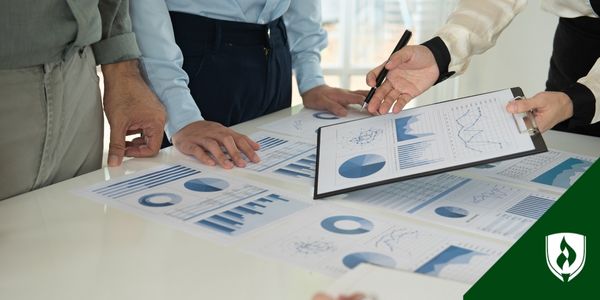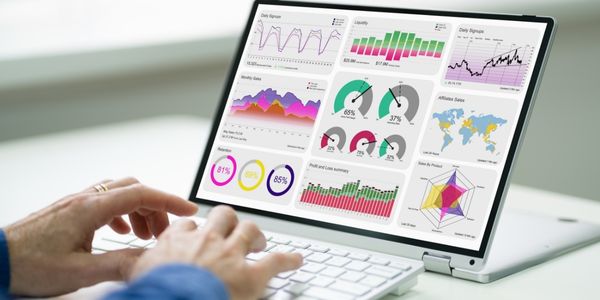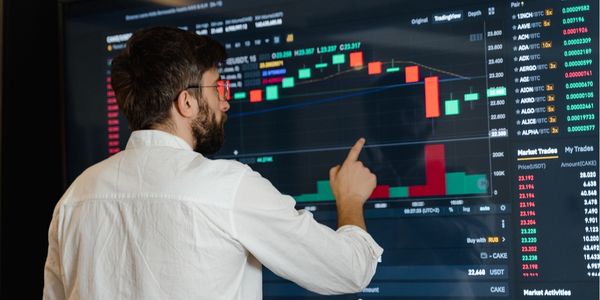
Data is everywhere these days. Businesses want to make data-driven decisions. And pretty much every industry wants to utilize the new capacities we have to gather information and turn it into better results, more efficiency and more profit.
But that much information, that much raw data is basically useless without data analytics. It's like dumping an ocean on someone and asking them to pull a dose of cough syrup out of it.
Data analysis allows you to navigate an ocean of information, identify trends, pull select insights, and most importantly—learn. Already know what data analytics is? Already know about data analytics, but curious to learn more about how to become a data analyst?
So, what is data analytics?
Data analytics is the action of collecting, organizing and finding ways to use huge amounts of information. It's simple to say. But data analysis is so versatile and can apply in so many different ways that data analytics isn't a job so much as an entire industry of jobs.
There's honestly so much going on in data analytics that it's overwhelming to just get a basic grip on the field. But when you do dive in, you’ll see how exciting the industry can be.
“Data is lit AF,” laughs Nathan Keysser, senior data analyst at BI Worldwide. “The ability to take large amounts of meaningless data and turn it into meaning, into something useful and interesting... it really satisfies that problem-solving itch.”
This is a really good field for people who enjoy puzzles, according to Keysser. If that’s you, keep reading. See how it works.
What does data analysis look like?
If you start from square one, there's a pretty straightforward process to data analytics. You can break all of these steps down into more steps if you want to get really detailed. But for a general understanding of how to analyze data, this is what you need to know.
Step one: Data collection
Data analysis can't happen without data collection—so that's the first step in the data analysis process. Companies, data analysts and data scientists need to figure out how to source information relevant to their needs.
This could look like your favorite shoe company sending out an automated survey after every purchase and collecting the results. Or it could be web cookies that record information about who visits a webpage, what they click on, how long they linger, etc... Data mining is a more-automated aspect of data science that's all about how to gather mass amounts of raw data for useful analysis.
Hospitals might use data from their electronic health records, law firms might analyze historical data on case studies, and environmental organizations might collect data about the soil, wind or solar conditions in hundreds of locations. Basically, you need a way to compile useful information before you can make use of it.
Step two: Data processing
Once you have lots of information, you have to organize it into a format you can easily sort or play around with. This might mean digitizing paper records, porting information from assorted files into one spreadsheet or hundreds of other methods.
This part of analyzing raw data is usually very time-consuming because you not only have to do a lot of manual, individual work—you also have to consider very carefully which aspects of information might be relevant. Otherwise, you’ll wind up doing the process all over again.
People used to ask is data analytics important enough to really splash out on expensive data analytics tools? But as people understand the power of data, it’s often more of a priority area. For a lot of companies, technology that can automate this time-consuming process and assist with data management might well pay for itself before too long.
Step three: Data analysis
Now we've reached the name of the game! After data is stored somewhere secure, accessible and sort-able, you're ready to actually analyze. How you analyze will vary a lot based on your organization, the needs of the moment and even how you prefer to work.
“Generally, I know what I want to find,” Keysser says. “But I frequently don't know how the data is structured, and I have to do a fair amount of problem solving to figure out exactly how I want to pull the data.” Keysser adds that since data analytics sounds so technical, many people don't realize how creative the work can be.
Data scientists and data analysts can approach analysis from many different angles. You could try to find the answer to a specific question. Ex: Will buyers in Illinois spend 15$ on this type of shirt?
Or you could pinpoint something and try to pull as much data related to that as possible. Ex: What is everything we know about people who've purchased a shirt from this website.
The options in data analytics are as wide as your imagination here. But there are defined types of data analytics that can give you some ideas.
Descriptive analytics
This type of analysis can be pretty simple. Descriptive analytics is all about answering the what, when, how types of questions in a given data set. For example, descriptive analytics could mean doing a simple statistical analysis to find the median number in a huge group of statistics.
Or to be more specific, a telehealth provider could keep track of when their clients with young children schedule consultations for strep throat. Descriptive analysis could help them track the months of the year with the most consultations over the last decade and isolate the peak times for strep throat consultations in children.
Descriptive analytics is a good first step to perform data analysis because it can help you identify errors like typos in your data, as well as find commonalities you may not have initially considered.
Diagnostic analytics
Diagnostic analytics goes a little deeper, into the "why" questions we can bring to data. This can range from technical questions (why does our website keep crashing) to more social/emotional questions (why are employees leaving our company).
For example, a company might wonder why they are experiencing higher turnover in their employees. Collecting information from exit interviews, they could use diagnostic analytics to pinpoint the problem areas employees most commonly cite and find ways to weigh the value of each reason.
Predictive analytics
Predictive analytics does exactly what it sounds like—predict things. If you analyze data on every tornado to ever hit the U.S., for example, you can use predictive analytics to help you determine when tornadoes might occur again in the future.
Since having some insight into future trends is highly-profitable for pretty much everyone, predictive analysis is an excellent way to draw valuable insights.
Prescriptive analytics
Prescriptive analytics is all about using data to choose the next course of action. It relies on predictive analytics, but then creates a recommended next step. This can be very helpful when there are lots of predictive variables involved. In the tornado example, cities could use a combination of data on when tornadoes are most likely to occur and what weather conditions will likely occur first and make a prescriptive decision about when they should run tornado warning sirens.
This type of data analytics often involves algorithms, machine learning or automation to help deal with all the raw data. Think about the way a credit card company might monitor transactions—that's way too much info for data analysts to wrangle. So, the company might create a prescriptive analytics algorithm to pay attention to spending patterns, flag anomalies and recommend a fraud or theft alert.
Then, if a customer buys something highly unusual, they will automatically receive a fraud alert and a hold on their card to limit potential damage if the card were stolen.
Step four: Data interpretation
As you can see from the types of data analytics, the whole point of all this is to draw meaningful conclusions from data.
After data is analyzed, those insights are now available. But it still takes some work to explain and translate. This is where data visualization and data modeling come in! You could have the highest quality data analysis in the world, but if people can't understand the results of your analysis, that hard work won't go anywhere.
One of the most important data analytics techniques is to create visual, clear ways to explain the data analytics process (and the results and recommendations) to people outside the field.
How do organizations use data analytics?
You're probably getting the picture already. An organization could use data analytics to answer questions about....
- What they are doing (who are our customers or clients, how much do we produce, where are we most successful)
- Why something is happening (why isn't this working, why is this working)
- What might happen in the future (when will we be busiest, how often is something likely to happen)
- What should happen next (at what point should we react, what is our best course of action when ___ happens)
It's hard to overstate the potential in all that.
It goes way beyond making more money too. Data analytics can help with healthcare, education, governing, economics, politics and all of the “this is too big to wrap my head around” elements of society.
“Knowledge is power,” Keysser says. “I know it's kind of cheesy to say that, but the more we can find truth in data, the better choices we can make about our future.”
The people who puzzle it out
Data analysts are one type of professional in the field of data analytics. If you like to solve problems, you might be curious to learn a little more about what it's actually like to work as a data analyst. All of this macro-level information is great for a general overview—but it gets way more interesting when you zoom in on the actual job.
Get those details at What Does a Data Analyst Do? Exploring the Day-to-Day of This Tech Career.




